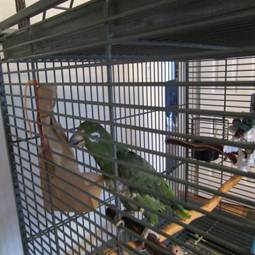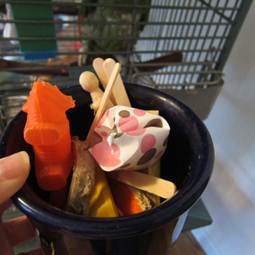Foraging is occupying time performing productive behavior
In the wild, birds are constantly looking for food; they are rarely lucky enough to sit down and have a full meal like our pet birds do. Foraging for food is a major part of a wild bird’s day as they fly from tree to tree looking for a treat.
We have all spoiled our pet birds by “giving” them food at all times. We have taken away their drive for foraging and have often times created a lazy/bored bird. A pet’s being bored can often lead to behavior issues; in birds that is often represented with feather pickers and screaming. How often do you see a bald bird in the wild?
Studies have proven that an active bird is not only a happier bird but a healthier bird. The following is a guideline to help make our caged birds have a productive life.
How can we create a foraging environment for our caged birds?
There are two options. You can either create a foraging tree or turn your bird cage into a foraging environment. Both options will be set up very similarly.
A foraging tree should be below your eye level and about 18 inches off the ground. We never want our birds to be above us and in control of us reaching them. This is the same for our bird’s cages.
Remember each bird learns at their own pace so adjusting to foraging may take longer in some birds then it does in others. Always read your bird and continue at a pace that is comfortable for your bird.
Setting up a foraging tree or foraging cage
- Place 5-7 food bowls, of different sizes and shapes around what we’ll call their “room”.
- Place a small amount of food in each of the bowls, placing favorite treats in newer bowls.
- Let your bird adjust to the new cage set up; once you have noticed that food has been taken from each feeding station you can move onto the next steps.
- Place a small sheet of paper over some of the feeding stations. What you’re looking for is your bird taking the paper off and then enjoying the food.
- Tape a small sheet of paper over some of the feeding stations; make a few small holes in the top of the paper. The holes will encourage your bird to find what’s under the paper.
- Tape a small sheet of paper over some of the feeding stations, with NO holes in the paper.
- Only have treats/food in some of the feeding stations.
- Hang ropes of different lengths with toys and/or nuts attached.
- Use paper bathroom cup, place treat inside and partially close opening of cup, place in feeding station.
- Use as sheet of paper with small treats on it, roll the paper into a ball and place in feeding station.
- Take above treat filled paper ball and place in a small lunch bag, tie with string, place a few holes in bag and hang in cage.
- Fill a feeding station with large untreated wood beads and hide treats and or food in bowl.
- Other household items that can be used include: empty paper towel or toilet paper rolls, small boxes (tissue/cereal), paper bags, popsicle sticks. Think non-toxic and consider the size.
- Nutri-Forage Pack and Snack is a Lafeber’s product that can be micro-waved (as directed) to soften and then pressed into food or toys to encourage foraging.
A must have for all bird owners: Captive Foraging, the Next Best Thing to Being Free –DVD Dr. M. Scott Echols, DVM Dipl ABVP-Avian Practice





